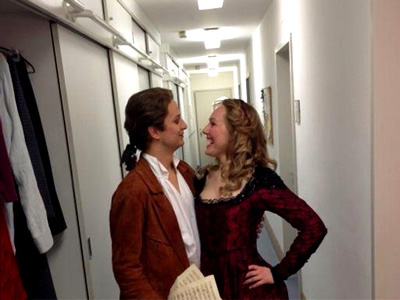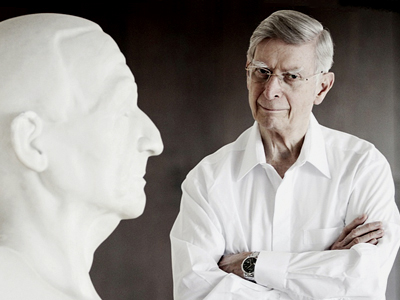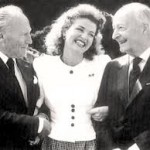By Brian Taylor Goldstein, Esq.
Dear Law & Disorder,
Our ensemble has recently had friction with its management over weather-related travel concerns. We had concerts scheduled during both Hurricane Sandy and this most recent blizzard in the Northeast, and as both approached, discussed postponing them with our management company. In both instances, they stated that since plane, train, and public transportation travel had been halted, we would need to rent a van and drive to the engagements. They said that due to the nature of our contracts, we would have to make every effort to get there no matter what. We had serious safety concerns about doing this, due to the predicted severity of the storms. In the end, it turned out in both instances that the presenters chose to reschedule the concerts for hopefully sunnier springtime dates, so we did not need to travel after all.
I know that our contracts with presenters include an “Act of God” clause, and my question is, who is empowered to make the decision about whether invoking this clause is the right thing to do? The presenter, our management company, or us? What if all three parties do not agree? Can we refuse to travel if we feel conditions are unsafe? Also, our ensemble is a non-profit organization, with the musicians hired as independent contractors. I am concerned that should we ever go ahead and travel to an engagement during bad weather conditions against our better judgment, and should an accident occur, that the individual musicians would have grounds to sue our non-profit for essentially telling them they must go. Would our management company be held responsible at all since they would not allow us to postpone? Help!
An “Act of God” clause is purely a creature of contract. It’s the terms of the contract (not God!) that defines what constitutes an “Act of God” and who gets to make the decision as to whether or not to invoke the clause. If the contract merely says something like: “This engagement may be canceled in the event of an Act of God”, it’s fairly meaningless. While I am familiar with lots of artists, managers, and presenters who prefer short and simple contracts, the problem with “short and simple” is that, in cases such as yours, it can also mean “vague and useless.” A good Act of God clause will define what constitutes an Act of God and who can make the determination, as well as address such issues as whether or not deposits need to get returned or engagements re-booked.
In your situation, to determine whether the nature of your contract, in fact, required you to make every effort to get there “no matter what,” I’d need to review your specific contract. However, I can’t image an engagement contract that actually required you to risk personal safely to get to the engagement—especially if planes, trains, and public transportation had all been halted. Even if you had, indeed, signed such a contract, there are always alternatives to risking personal safety merely to comply with a contract—including a legal defense called “impossibility of performance.”
Regardless of what a contract says or doesn’t say, the ultimate decision to cancel or postpone an engagement, whatever the reason, is always yours. Whether you’re canceling or postponing because you feel you cannot travel safely or canceling because you want to pursue a more enticing offer, those decisions are yours to make, not your manager’s.
Similar to Act of God clauses, manager/artist relationships are also defined and determined by contracts. However, unlike Act of God clauses, most state laws impose two legal obligations on all agents and managers which can never be waived or altered by contracts: (1) All managers owe a fiduciary duty to their artists (ie: they must put the artist’s interest above their own) and (2) All managers must follow the instructions and directives of their artists. (There are other obligations, too, but these are the most important.)
Like an attorney, a manager is there to provide advice, counsel, and direction, but not to give orders or commands. Unless a manager is also a producer, the manager works for the artist, not the other way around. Final decisions are always yours to make. Of course, the consequences—including being sued by presenter for breach of contract—are solely yours to bear, as well.
Granted, the manager/artist relationship should always be one of mutual respect, otherwise it doesn’t work for either of you. If a manager feels you are not taking their advice and counsel, and, as a result, you are adversely affecting your career, then the manager may rightly choose to no longer work with you. Likewise, if there comes a point when you believe your manager is putting his or her interest above your own, its time to move on.
As for your liability question, let’s save that for another post. For now, suffice it to say, under our less-than-intuitive legal system, anyone can sue anyone else for just about anything—especially if an artist is injured because you required them to drive in poor weather conditions. Get insurance! Stay tuned.
_________________________________________________________________
For additional information and resources on this and other  legal and business issues for the performing arts, visit ggartslaw.com
legal and business issues for the performing arts, visit ggartslaw.com
To ask your own question, write to lawanddisorder@musicalamerica.org.
All questions on any topic related to legal and business issues will be welcome. However, please post only general questions or hypotheticals. GG Arts Law reserves the right to alter, edit or, amend questions to focus on specific issues or to avoid names, circumstances, or any information that could be used to identify or embarrass a specific individual or organization. All questions will be posted anonymously.
__________________________________________________________________
THE OFFICIAL DISCLAIMER:
THIS IS NOT LEGAL ADVICE!
The purpose of this blog is to provide general advice and guidance, not legal advice. Please consult with an attorney familiar with your specific circumstances, facts, challenges, medications, psychiatric disorders, past-lives, karmic debt, and anything else that may impact your situation before drawing any conclusions, deciding upon a course of action, sending a nasty email, filing a lawsuit, or doing anything rash!



